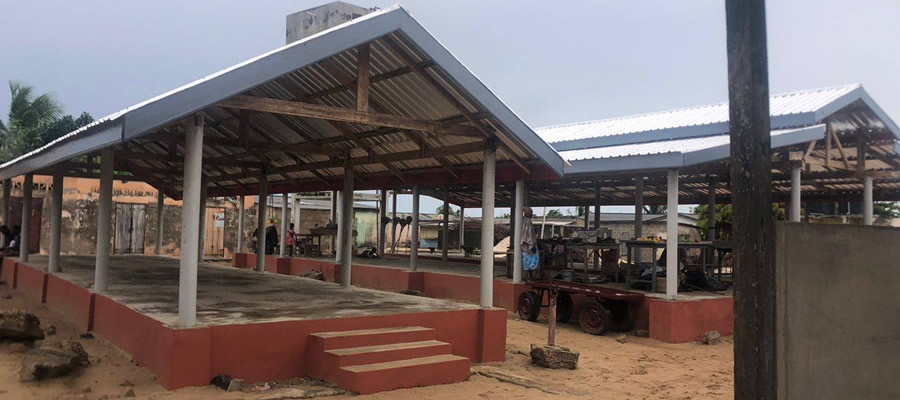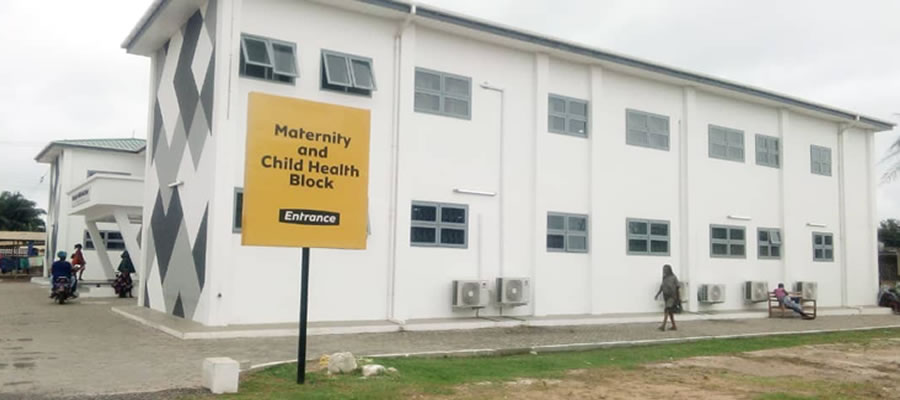

Population
The 2010 Population and Housing Census put the total population of the Municipality at 147,618 which forms 7.0 percent of the Regional total population. The population constitutes 53.6 percent females and 46.4 percent males with an annual growth rate of 1.10 percent. The Municipality is the most urbanized district in the region with more than half 53.3 percent of the district’s population living in the urban areas with 46.7 percent of the population living in the rural areas.
Environmental situation
The current natural environmental conditions in the Municipal are characterized by a number of problems.The Savietula-Dzita-Anyanui stretch of the Municipality is facing a severe sea erosion problem whilst that of the Keta-Horvi has been solved by the Sea Defence Project.
In 30 addition, the area occupied by the Keta Lagoon is so dependent on the amount of rainfall and also rivers and streams in the upper course that feed it. It can reduce significantly, particularly in Anyako and Afiadenyigba areas when there is severe drought and the lagoon may recede well over a kilometre. This is attributed to siltation, high evaporation, and declining rainfall. Even though the situation is not permanent with regards to water level in the lagoon it is largely determined by the rainfall pattern in every year.
Along the coast, the beauty of the coconut plantations has been wiped out as a result of the Cape St. Paul wilt disease. At the south-western end of the Municipality, (Anyanui-Bomigo), extensive commercial harvesting of the mangrove for domestic and industrial use has rendered some areas almost bare. These problems have aggravated the soil erosion problem, while adversely affecting both fishing and crop farming. Table 10 gives a summary of various categories of environmental problems and the location of the most affected areas.
It must be noted that most of the environmental problems assume regional dimensions and the causes are largely human related. Hence, environmental protection measures must consider these dimensions if they are to be effective
LOCATION AND CATEGORY OF ENVIRONMENTAL DEGRADATION
AREA | CATEGORY OF DEGRADATION |
Keta – Heluvi | Sea Erosion
|
Anyanui – Dzita | Depletion of Mangrove
|
Keta lagoon basin, and creeks | Silting of lagoons and creeks. |
In most settlements especially Anyako, Keta and Afiadenyigba. |
Indiscriminate domestic liquid and solid waste disposal. |
Northern sections of the Municipality | Bush fire and shifting cultivation. |
Cape St. Paul and surrounding areas. | Depletion of coconut trees along the coast due to the infestation of the Cape St. Paul wilt disease. |
At the littoral | Water pollution due to seepage of agro-chemicals, household and human waste into underground water sources. |
SOURCE: By DPCU Survey in 2000.
(i) Farming:
The declining soil fertility in the district has necessitated an increased use of manure, chemical fertilizers and water for irrigation. This has caused ground water pollution and increased salinity of soils. The increased pressure on land, particularly along the coast, has left the soils fragile and susceptible to erosion.
(ii) Fishing:
Fishing practices, which have increasingly involved the use of agro-chemicals, explosives (TNT), and unauthorized fishing nets as well as the old traditional ‘”atidza”. This has led to the pollution of the water bodies, and the depletion and extinction of some fish species. Generally there is over fishing in Keta Lagoon.
(iii) Wood Cutting:
This is an important economic activity. The intensified harvesting of red and white mangroves growing around Anyanui, Atorkor and Salo for domestic and commercial use has further aggravated the soil erosion problem. Furthermore, the habitat and breeding places of fish and bird species have been destroyed.
(iv). Coastal Sand-winning:
The winning of sand in Keta Municipal is also an established economic activity. The extensive winning of sand along the coast especially around Dzita, Atorkor, Dzelukope, Tegbi, Woe areas have exacerbated the effect of the sea erosion. In consequence, this has destroyed the sand dunes and coastline that hold so much potential for the development of Tourism.
(v). Quarrying:
The clay deposits found at Tunu, Bomigo, and Srogboe, have been exploited by the indigenous people on a very small scale. This is however envisaged to increase as a result of the Municipal Assembly’s intention to exploit the Bomigo clay deposit on a commercial scale. There is therefore the need for an environmental impact assessment, before large-scale exploitation of the clay deposits. The significance of the economic activities discussed above cannot be overemphasized. Yet, for the sustainability of the natural environment there is the need to put in place mechanisms to check excesses.
Built Environment
Numerous buildings have been eroded by the sea over the last few decades. These include residential, commercial, administrative, historical buildings, and many more. Among the historical sites are the Danish Fort Prinzenstein, Cape St Paul light house. Their restoration and maintenance is significant as these are some of the attractions envisaged to promote Tourism.
Aesthetic Features
Areas in the district endowed with aesthetic value include:
• The Lagoon Basin and the islands Hevikpo and Dudu which forms the sanctuary for large species of birds. The preservation and conservation of these natural places can form the basis of a tourism industry.
• The sand beaches along the entire coast especially the Cape St. Paul area. The beaches also hold potential for tourism.
• The Volta Estuary at Atiteti. The fascinating point where the Volta River merges with the Gulf of Guinea.
• Taleto Lagoon at Whuti and the Keta Lagoon hold so much aesthetic value, while complementing the already noted economic significance.
• Measures to improve and preserve the above aesthetic places would enhance environmental quality and tourism.
Implications For Development
There is the need to balance human activity for sustainable
development.
• To mitigate adverse environmental impact there is the need to institute effective regulatory measures.
• For medium and large-scale development projects, Environmental Impact Assessment report should be a prerequisite.
Introduction/Objectives
This report essentially highlights on situational events in the Keta District during the period under review. Thus from January 2003 to June 2006. The Disaster Management focus objectives as per Keta Municipal Disaster Management Plan are: -
- to handle all aspects of disasters in the Keta Municipal
- to focus attention on preventing and reducing occurrence of aspects of
disaster on society
- Map out strategic plans towards the inevitable disaster in the near future.
- To assist and guard towards disaster preparedness planning, emergency response, rehabilitation and reconstruction efforts.
- To disseminate information for public consumption and awareness creation.
- To assist and motivate communities/groups within the Keta district to serve as credible voluntary organizations in the provision of social amenities and also to enforce preventive laws to prevent disasters.
Keta Municipal has experienced several types of disasters from time to time. Among these as regards the period are devastation by coastal erosion as a result of tidal waves disasters. Others are fire, rainstorm, river, lagoon and epidemics like cholera which became persistent in the Anlo-Afiadenyigba Township and its immediate environs.
Population Size and Growth
Keta Municipal population has been growing at a relatively low rate of 0.5 per cent since 1970. From a total population of 104,100 in 1970, it reached about 111,700 in 1984. The 2000 population census puts the total population at 133,661 which forms 8.2% of the Regional total population. It shows an inter-censual growth rate of 1.1 since 1984 this is below the Regional and National inter-censual growth rate of 1.9 % and 2.7 % respectively.
It may be observed in Table 3 that relative to both Regional and National trends, the district annual population growth rate of 0.5 percent between 1970 and 1996 is low. The growth rate increased to 1.3% between 1984 and 2000. The Regional and National growth rates between 1970 and 1984 were 2.0 per cent and 11. 2.6 per cent respectively. This changed to 2.5% and 1.8% respectively between 1984 and 2000, which are still higher than the 1.3% recorded for Keta in 2000.The low population growth rate is attributed to a very high out-migration (281/1000 per year) of the district’s potential labour force.
The main push factor seems to be the lack of employment opportunities. This is evidenced by a relatively high unemployment rate of 38 per cent as against the estimated 28 per cent for the nation. Other factors contributing to out migration are the dwindling of fish catch, low crop yields, low land per capita and the limited market for industrial produce, intensive sea erosion, among others.
REGION AND KETA DISTRICT (1970-1996)
AREA |
1970** | GROWTH RATE |
1984** | ANNUAL GROWTH RATE |
2000** | ANNUAL GROWTH RATE |
Ghana
|
8,560,000 |
2.6 |
12,206,000 |
2.6 |
18,412,247 |
2.5 |
Volta Region |
947,300 |
2.0 |
1,211,900 |
2.0 |
1,612,299 |
1.8 |
Keta District |
104,100 |
0.5 |
111,700 |
0.5 |
133.661 |
1.3 |
Ghana Population Census Reports, 1970, 1984, 2000, Statistical Services, Accra.refer to pdf table for Table 4 shows that most of the settlements are losing population. It shows population growth by selected settlements since 1960. The growth rate ranges from – 3.7 per cent in sea erosion prone area of Kedzi to 5.2 per cent in Hatorgodo. Other settlements which are fast losing population include Keta, Anyako, Afiadenyigba, Atiavi, Nolopi, and Kedzi. The spatially widespread negative growth rate indicates maximum extra district out-migration and minimum intra-district migration.
The district is relatively more urbanized based on the criterion that any settlement with a population of 5000 or more represents an urban centre. As shown in Table 5, about 53.2 per cent of the estimated total population in 2000 resides in urban centres as compared to corresponding regional and national figures of 2.7 per cent and 32.0 per cent respectively 1984. The situation in 1996 has not changed in any significant way in 2000.The numerous rural settlements scattered over the whole district make efficient service provision difficult.
Hierarchy of settlements (based on population) is shown in Table 6. Refer to pdf file Three main population density zones may be identified. The average density for the district is 164 persons/km2 (water bodies excluded), which is significantly higher compared with the national and regional figures of 65.7 persons/km2, and 69.1 persons/km2 respectively. This can be attributed to the presence of large water bodies, which occupy 1/3 of the total land area.
The main population density zones are:The coastal area comprising a narrow strip of sand bar between Anloga and Keta where the density rises to about 500 persons/km2 compares favourably with densities in Greater Accra Region (609.7 persons/km2 which is the highest in the country. It is the most serviced area and is also noted for intensive shallot farming.
The Hierarchy of settlements as shown in Fig 6: Efforts have been made to deneliate the sphere of influence each community has by the services/facilities provided as in the scalogram or the functional matrix in figure 7. In the measure settlements with population between 150 and 20,000 and above were considered. The physical location of the service or facility irrespective of the name given to the service centre e.g. Keta Secondary School is in Dzelukope and Keta District Hospital is in Dzelukope etc. In all 40 settlements with major services or facilities at different levels were considered with the following:
- Number of functions provided by each community
- Total weighted centrality score
- Hierarchy level of the settlements
Implications/Findings:
- Anloga with the highest population has the highest number of functions (32) with Dzelukope (22), Tegbi (22), Abor (28) and Keta (20) in that order as the first level.
Hierarchical Settlements.
- Three (3) settlements in the second level hierarchy.
- Twenty Five (25) other settlements fall within the third level hierarchical order and the rest falling in the fourth level.
The spatial inequality or equity in the distribution of facilities corresponds very much to population distribution which is heavily biased towards the coastal belt which accounts for the greater portion of the District population. One striking feature is Abor which has a smaller population of 4,753 falls within the first level hierarchy in terms of functionality.
This is an indication that Abor has the capacity as a potential growth point in the District economy. Similarly all the UTAs headquarters in the highest poverty stricken pockets like Tregui, Alakple, Atiavi, Anyako and Anlo-Afiadenyigba could be centres of investments in future interventions in poverty reduction strategies as growth centres in the District.
A wide range of industrial activities has been identified in the Municipality. All the industries, which are small scale, are owned and managed mainly by sole proprietors. This sector employs about 13.0 per cent of the labour force of the district and constitutes seven primary or supplementation sources of livelihood.
Population Size and Growth
Keta Municipal population has been growing at a relatively low rate of 0.5 per cent since 1970. From a total population of 104,100 in 1970, it reached about 111,700 in 1984. The 2000 population census puts the total population at 133,661 which forms 8.2% of the Regional total population. It shows an inter-censual growth rate of 1.1 since 1984 this is below the Regional and National inter-censual growth rate of 1.9 % and 2.7 % respectively.
It may be observed in Table 3 that relative to both Regional and National trends, the district annual population growth rate of 0.5 percent between 1970 and 1996 is low. The growth rate increased to 1.3% between 1984 and 2000. The Regional and National growth rates between 1970 and 1984 were 2.0 per cent and 11. 2.6 per cent respectively. This changed to 2.5% and 1.8% respectively between 1984 and 2000, which are still higher than the 1.3% recorded for Keta in 2000.The low population growth rate is attributed to a very high out-migration (281/1000 per year) of the district’s potential labour force.
The main push factor seems to be the lack of employment opportunities. This is evidenced by a relatively high unemployment rate of 38 per cent as against the estimated 28 per cent for the nation. Other factors contributing to out migration are the dwindling of fish catch, low crop yields, low land per capita and the limited market for industrial produce, intensive sea erosion, among others.
REGION AND KETA DISTRICT (1970-1996)
AREA |
1970** | GROWTH RATE |
1984** | ANNUAL GROWTH RATE |
2000** | ANNUAL GROWTH RATE |
Ghana
|
8,560,000 |
2.6 |
12,206,000 |
2.6 |
18,412,247 |
2.5 |
Volta Region |
947,300 |
2.0 |
1,211,900 |
2.0 |
1,612,299 |
1.8 |
Keta District |
104,100 |
0.5 |
111,700 |
0.5 |
133.661 |
1.3 |
Ghana Population Census Reports, 1970, 1984, 2000, Statistical Services, Accra.refer to pdf table for Table 4 shows that most of the settlements are losing population. It shows population growth by selected settlements since 1960. The growth rate ranges from – 3.7 per cent in sea erosion prone area of Kedzi to 5.2 per cent in Hatorgodo. Other settlements which are fast losing population include Keta, Anyako, Afiadenyigba, Atiavi, Nolopi, and Kedzi. The spatially widespread negative growth rate indicates maximum extra district out-migration and minimum intra-district migration.
The district is relatively more urbanized based on the criterion that any settlement with a population of 5000 or more represents an urban centre. As shown in Table 5, about 53.2 per cent of the estimated total population in 2000 resides in urban centres as compared to corresponding regional and national figures of 2.7 per cent and 32.0 per cent respectively 1984. The situation in 1996 has not changed in any significant way in 2000.The numerous rural settlements scattered over the whole district make efficient service provision difficult.
Hierarchy of settlements (based on population) is shown in Table .Three main population density zones may be identified. The average density for the district is 164 persons/km2 (water bodies excluded), which is significantly higher compared with the national and regional figures of 65.7 persons/km2, and 69.1 persons/km2 respectively. This can be attributed to the presence of large water bodies, which occupy 1/3 of the total land area.
The main population density zones are:The coastal area comprising a narrow strip of sand bar between Anloga and Keta where the density rises to about 500 persons/km2 compares favourably with densities in Greater Accra Region (609.7 persons/km2 which is the highest in the country. It is the most serviced area and is also noted for intensive shallot farming.
The Hierarchy of settlements as shown in Fig 6: Efforts have been made to deneliate the sphere of influence each community has by the services/facilities provided as in the scalogram or the functional matrix in figure 7. In the measure settlements with population between 150 and 20,000 and above were considered. The physical location of the service or facility irrespective of the name given to the service centre e.g. Keta Secondary School is in Dzelukope and Keta District Hospital is in Dzelukope etc. In all 40 settlements with major services or facilities at different levels were considered with the following:
- Number of functions provided by each community
- Total weighted centrality score
- Hierarchy level of the settlements
Date Created : 11/21/2017 4:07:23 AM










 facebook
facebook
 twitter
twitter
 Youtube
Youtube
 +233 593 831 280
+233 593 831 280 0800 430 430
0800 430 430 GPS: GE-231-4383
GPS: GE-231-4383 info@ghanadistricts.com
info@ghanadistricts.com Box GP1044, Accra, Ghana
Box GP1044, Accra, Ghana